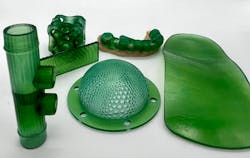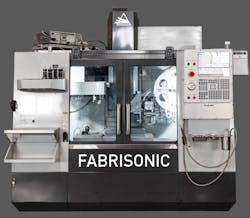The Rapid + TCT additive manufacturing conference concluded its 2023 session last week and, as always, provides a bird’s eye view of what the future holds for the dynamic industry. IndustryWeek regularly covers new additive developments that in retrospect one cannot imagine the technology existing without. New material options, advanced software development, integration into standard manufacturing and Industry 4.0 processes enhance existing additive techniques and methodologies while the most important breakthrough, mass production on the scale of traditional technology, continues to elude.
Here are the Rapid + TCT 2023 highlights noted by IndustryWeek and what they portend for the future of additive manufacturing.
Building with New Blocks
Two companies announced new materials that caught our attention. Photopolymer resin developer polySpectra announced its first biocompatible 3D material, COR Bio, designed for the harsh treatment of high temperature, disinfecting autoclaves and generally durable otherwise. Two potential applications include COVID ventilator valves and orthotic shoe inserts.
3D Systems revealed a pair of new copper alloys: GRCOp-42, designed for high-temperature, high-thermal transfer applications like rocket engines, and Copper-Chrome-Zirconium (CuCr1Zr), that 3D Systems suggests as a post-processing material to enhance strength and conductivity of parts. A great example of additive supporting both manufacture of original parts and enhancing parts manufactured traditionally.
New 3D Printers and Modifications
Fabrisonic introduced the SonicLayer 1600, a hybrid platform that simultaneously offers additive and subtractive capability. An ultrasonic additive manufacturing platform (Fabrisonic uses a technique that employs sound waves to merge layers of metal foil) and mid-sized CNC/milling platform sit in the same machine. Definitely cool stuff. (Thanks to our colleague Sara Jensen, from Power & Motion, who attended Rapid + TCT 2023 and made sure we noted this new printer.)
The new Fabrisonic printer could encourage small- to mid-sized manufacturers reticent to rework floorplans to accommodate new machines but who want to adopt additive. 3D Systems introduced two modifications for its printers, a material delivery module that makes it easier to use multiple material types on the same platform (potentially cutting down time needed for material purges and reloading), and a build changeover station that decreases time to clean up unused powdered metal, remove the finished part, refresh materials and get ready to print the next part.
HP announced a pair of new products to ease automation workflows for additive manufacturing, a material processing system and a system for exchanging two consecutive prints simultaneously. The company also revealed a new proof-of-concept demonstration taking place at HP’s collaboration hub in Barcelona, Spain, that pairs autonomous mobile robots (AMRs) with additive machines.
Learning New Methods
Finally, on the R&D front, additive manufacturing company Spee3d, that uses the cold spray method for 3D printing (powdered metal particles suspended in gas deform into solid matter when blasted at high speed onto a substrate, like a build plate), announced a new partnership with the University of California, Irvine Department of Materials Science and Engineering, backed with grant support from the Air Force office of scientific research. The partnership will focus on the development of cold spray materials and what’s possible with the technique.





